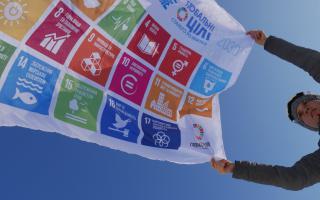Thought Leadership Course - Synergizing Disaster Risk Reduction and Climate Change Adaptation
In this thought leadership module, developed in partnership with the UN Office for Disaster Risk Reduction (UNDRR), you will explore the fundamental aspects of harnessing Disaster Risk Reduction (DRR) and Climate Change Adaptation (CCA) synergies and the lessons learnt by those who are at the forefront of comprehensive disaster and climate risk management.
Disaster risk reduction and climate change adaptation are synergistic, given the common risk-reduction and vulnerability-reduction objectives of both actions. However, the governance of the two has evolved in parallel at both global and national levels. National DRR strategies and National Adaptation Plans are often developed in isolation from each other, resulting in a suboptimal utilization of resources.
Conversely, synergy in risk reduction and adaptation can yield considerable gains. Global multilateral processes have evolved to encourage and facilitate these synergies. The Paris Agreement recognizes the need to reduce risk (including through sustainable development) and enhance understanding, action and support on the loss and damage associated with the adverse effects of climate change.
The Sendai Framework for Disaster Risk Reduction seeks to strengthen alignment through national and local DRR strategies wherein coherence in policy is a stated objective, as well as through an understanding of disaster risk that integrates climate change.
The 2030 Agenda for Sustainable Development and its Sustainable Development Goals (SDGs) also support this approach in various SDGs, including through Goal 13 on Climate Action wherein DRR is addressed. Hence, the alignment of national adaptation plans and disaster risk reduction plans is a key enabler for the implementation of these important frameworks.
Upon successful completion of this course, participants should:
- Have a clear understanding of the synergies between DRR and CCA.
- Be able to define integration between DRR and CCA .
- Identify good practices on DRR-CCA integration and implementation
- Facilitate further changes in attitudes and behaviours towards the integration of disaster risk reduction and climate change adaptation.
UNSSC online courses are designed to deliver maximum learning outcomes through carefully chosen high-quality learning materials.
This online course combines a self-paced study module with applied learning components, such as case studies and interactive scenarios.
The course presents successful case stories about countries that have harnessed the synergies between Disaster Risk Reduction and Climate Change Adaptation, optimizing scarce resources and strengthening resilience.
UNSSC online courses give learners the opportunity to complete activities when it best fits their schedule. Participants are largely free to determine their own weekly study plan. Demanding two hours of study, this UNSSC online course incorporates the same high academic rigour as any UNSSC face-to-face programme.
Understanding synergies and the rationale behind it
- Lesson 1: Disaster Risk Reduction and Climate Change Adaptation: Identifying the connections.
- Lesson 2: Understanding the need for a synergized approach.
Journeys to harnessing DRR-CCA synergies
- Lesson 3: Promising beginnings: Harnessing synergies.
- Lesson 4: Advancing the process: integrated approaches at the implementation level
- Lesson 5: Building durable synergies across dimensions
- Activity: Simulating scenarios to bring DRR and CCA closer
Final reflections on synergized approaches to DRR and CCA
- Lesson 6: Opportunities for enhanced synergies
- Key messages
The module is targeted at decision-makers and -shapers, and disaster risk reduction and climate change adaptation focal points, who are directly involved in developing national Disaster Risk Reduction strategies and National Adaptation Plans at the local, subnational, national, regional, and international levels.
Other officials and stakeholders that can contribute to advancing Disaster Risk Reduction and Climate Change Adaptation synergies can also make use of the course.
This course is free of charge.



